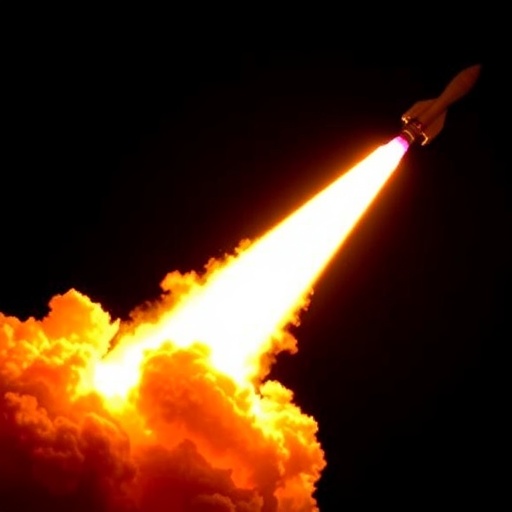In a groundbreaking advancement for the aerospace industry, a research team from LandSpace Technology has pioneered a novel numerical framework to accurately predict radiative heating during rocket descent. This innovative approach addresses a critical challenge for reusable launch vehicles—a sector that is rapidly evolving to meet the demands for cost-effective and sustainable space access. Traditional radiative heating prediction methods often falter due to excessive computational costs and insufficient physical accuracy, but the new framework promises a breakthrough, particularly for rockets employing clustered engine configurations like the Zhuque-2.
The newly developed methodology seamlessly integrates a detailed radiation transfer model with a wide-band k-distribution model, harnessing the high-temperature Spectroscopic database known as HITEMP2010. This synergy enables researchers to track radiative paths more efficiently, effectively bridging the gap between computational fluid dynamics (CFD) and precise radiative heat flux forecasts. The ramifications of this research extend far beyond theoretical prowess; they pave the way for practical solutions in the design and operation of next-generation spacecraft.
At the heart of the innovation is an intelligently constructed computational pipeline that transforms complex CFD flow-field data into accurate predictions of radiative heat flux. This process incorporates pressure corrections to accommodate altitude-dependent molecular density variations—an essential factor that significantly influences radiative heating profiles. Additionally, the establishment of automated data-coupling protocols enhances the robustness and efficiency of the simulation tool, setting a new standard in thermal analysis.
Validation efforts against high-resolution Statistical Narrow Band benchmarks revealed that the newly devised framework maintains remarkable accuracy, achieving maximum relative errors below 6%. Impressively, all of this was accomplished at a computational cost that was less than 20% of traditional line-by-line methods, effectively reconciling the long-standing dilemma of achieving high precision while managing rigorous computational resources. This advancement represents a substantial leap forward, as it resolves the conflicting requirements that have historically plagued the thermal analysis of reusable launch vehicles.
In applying this innovative methodology to the analysis of LandSpace’s nine-engine LOX/CH4 rocket system, the research team discovered critical insights into the rocket’s thermal environment throughout its flight phases. During the ascent phase, radiative heating peaked dramatically at 50 kW/m² at liftoff, before significantly diminishing by 80% beyond 20 kilometers in altitude. These findings illustrate the drastic thermal changes that reusable rockets undergo, providing valuable data for engineers tasked with optimizing thermal protection systems.
The return phase of the rocket flight presented even more compelling data. Here, sidewall heating reached an astonishing 29.1 kW/m² at an altitude of 40 kilometers, marking a 30% increase over base heating levels at that altitude. When the rocket operated on three engines, the base heat flux was found to be 186% greater when compared to single-engine mode, indicating the intense thermal interactions present in multi-engine configurations. Most intriguingly, the study uncovered previously undocumented thermal transitions occurring during landing, with sidewall heating dropping 83% below 4 kilometers and base heat flux decreasing to a mere 7.8 kW/m² during final descent.
Moreover, these revelations not only offer groundbreaking insights into the thermal behavior of reusable launch vehicles but also underscore the significant engineering value that this research holds. Dr. Qian Wan, the corresponding author of the study, explained, “Our methodology represents the first systematic effort to quantify radiative heating distributions across all phases of flight.” This innovative approach provides invaluable direct inputs for optimizing thermal protection materials and managing cryogenic propellant strategies—areas where precision is crucial, especially for China’s next generation of reusable, methane-fueled launch systems.
The adaptability of this numerical framework further amplifies its significance across the entire aerospace industry. Its potential applications span various vehicle configurations, thus heralding a broader impact that transcends any single rocket design. As reusable launch vehicle technology continues to advance worldwide, this research lays down a vital computational foundation essential for mastering the intricate thermal environments that characterize future space missions.
Looking forward, the LandSpace Technology team has ambitious plans for experimental validation. They intend to use ground test and flight data to enhance the robustness of their newly developed model, ensuring that it not only performs well in simulated environments but also stands up to real-world conditions. As the global aerospace industry moves closer to realizing the full potential of reusable launch vehicles, this research promises to be a game-changer, providing tools that are at the forefront of thermal analysis.
In conclusion, the development of this advanced numerical framework represents a significant milestone in the science of rocket design and thermal management. By combining innovative modeling techniques with practical engineering insights, LandSpace Technology is poised to shape the future of reusable launch vehicles, making space access more efficient and sustainable than ever before. The implications of this research are profound, not only for the Chinese space program but also for the global project of exploring the cosmos in a way that is both economically viable and environmentally conscious.
Through continuous efforts to refine and validate their model, the researchers aim to contribute to the next era of human and robotic exploration of space. As the boundaries of aerospace engineering expand, one thing is clear: understanding and predicting the thermal environments of launch vehicles will be indispensable for the challenges that lie ahead.
Subject of Research: Radiative heating prediction in reusable rocket design
Article Title: Numerical approach for radiative-heat-transfer of a reusable liquid-propellant launch vehicle
News Publication Date: 22-May-2025
Web References: http://dx.doi.org/10.1016/j.cja.2025.103581
References: Zhenhua ZHOU, Qian WAN, Lei SHI, Guang ZUO, Yuhong CUI. Numerical approach for radiative-heat-transfer of a reusable liquid-propellant launch vehicle [J] Chinese Journal of Aeronautics, 2025.
Image Credits: Credit: Chinese Journal of Aeronautics
Keywords
Radiative heating, reusable launch vehicles, thermal analysis, LandSpace Technology, CFD, HITEMP2010, methane-fueled rockets, aeronautical engineering, numerical modeling, aerospace innovation.




